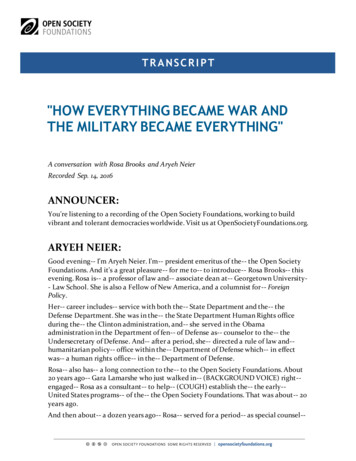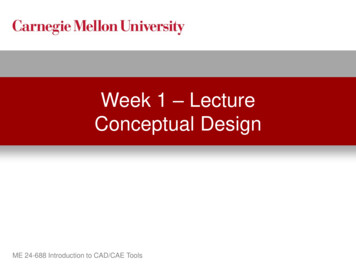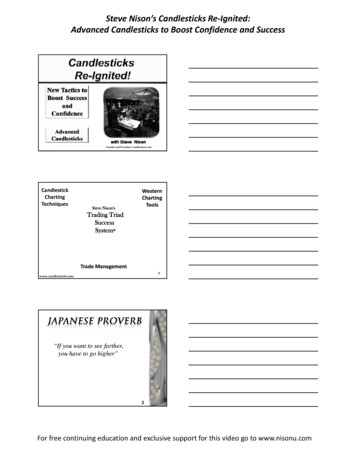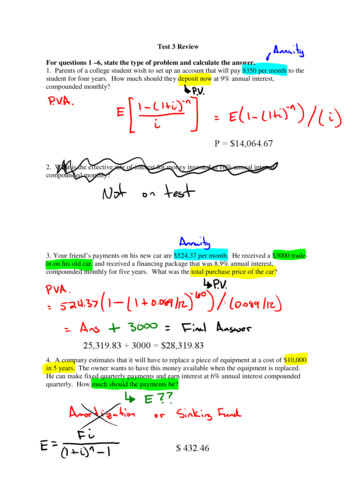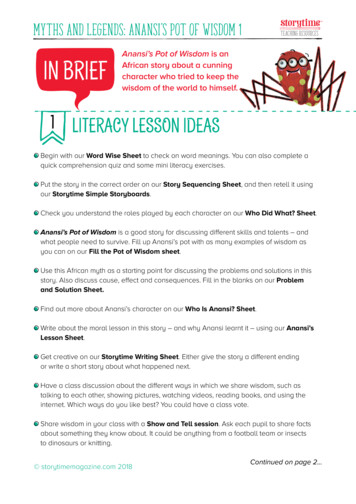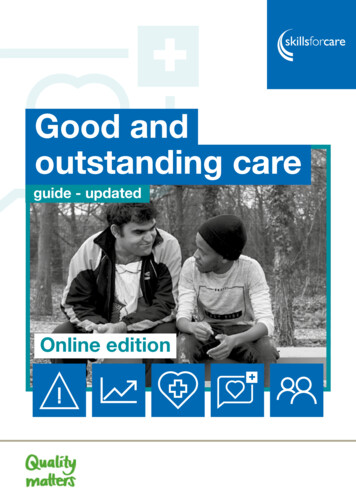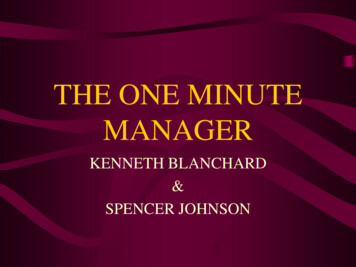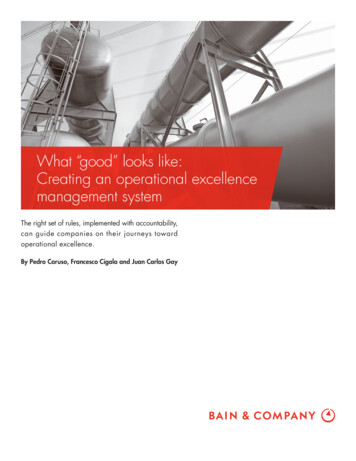
Transcription
What “good” looks like:Creating an operational excellencemanagement systemThe right set of rules, implemented with accountability,can guide companies on their journeys towardoperational excellence.By Pedro Caruso, Francesco Cigala and Juan Carlos Gay
Pedro Caruso is a partner with Bain & Company in Houston. Francesco Cigalais a Bain partner in Kuala Lumpur. Juan Carlos Gay is a Bain partner in London.All three are members of the firm’s Global Oil & Gas practice.Copyright 2013 Bain & Company, Inc. All rights reserved.
What “good” looks like: Creating an operational excellence management systemUnlike Aristotle’s audience, however, a company cannotsimply decide to get better. Because they are large, complexorganizations, companies demand a systemic approachto improvement: an operational excellence managementsystem (OEMS).“Excellence is an art won by trainingand habituation. We do not act rightlybecause we have virtue or excellence,but we rather have those because wehave acted rightly. We are what werepeatedly do. Excellence, then, is notan act but a habit.”–AristotleTwo decades ago, Exxon deployed the first and best knownOEMS in response to the Valdez oil spill. The companyhas since gone on to refine and improve the approachover the years, and it has become a model for others inthe industry. Today, most international oil companies(IOCs), national oil companies (NOCs) and many otherenergy companies have management systems in place thatreflect their aspirations for excellence. These systemsdescribe the expectations for performance by all of thecompany’s operations (see Figure 1).Though he was probably speaking to artists, craftsmen andstudents, Aristotle could have been talking to today’s oil andgas industry executives when he wrote those words 2,300years ago. We know from our conversations with industryexecutives that they aspire to the same ambitious goalsas Aristotle’s listeners. They want their businesses to runsafely and more efficiently: to demonstrate operational excellence. But aspirations are not enough; excellence is a habitthat results from millions of small acts, performed everyday by tens of thousands of employees.Because they are so widespread, putting an OEMS inplace no longer differentiates a company or ensuressuperior performance; it’s merely a first step. Breakthrough performance depends on how well you embedthe system, from the front line to the back office, andhow employees act on it day after day. In other words,this isn’t just about designing new systems, it’s aboutteaching people a new way of working and then continuously getting better at it.Figure 1: The typical elements of an operational excellence management system (OEMS) span acrossfunctions and regionsHealth, safety, security and environmentAsset integrity and reliabilityStrategy and leadershipContractor managementOrganization and capabilitiesCapital projectsPerformance managementOperational riskChange managementIncidents and emergenciesPlanning and optimizationExternal stakeholders’ responsibilityOperations and productionSupply chain managementSource: Bain & Company1
What “good” looks like: Creating an operational excellence management systemWhat is an OEMS? An operational excellence management system isn’tjust a manual. It’s a set of rules that describe how acompany is going to operate in order to achieve operational excellence. The best examples are focused, simpleand relentlessly applied. A solid system: sets global expectations for operations defines common language that everyone in theorganization can use to talk about operations andtheir aspirations shares successful practices and behaviors acrossthe organization maps accountabilities from the top to the front line promotes continuous improvementBase the implementation approach on business objectives,and integrate the system into the way the business operates.For example, if the primary aim is to reduce operationalrisks, then prioritize development and deployment of subsystems linked to risk control and management. If, onthe other hand, the goal is to improve operational efficiency,then prioritize the sub-systems related to maintenanceand turnarounds. In any case, focus on the geographicareas or operations that have the largest opportunity forimprovement. Management tools, including planningand performance management, should be updated toreinforce the OEMS.Many companies spend too much time preparing themanual and not enough implementing it with accountability measures that ensure compliance. Successfulcompanies focus more on implementation and compliance to get the most out of the effort.The most effective way to roll out a major transformationaleffort like this is with a sponsorship spine, in which directmanagers introduce it to their reports at every level ofthe organization. It starts at the top, where a steeringcommittee sponsors and directs the project. Committeemembers work with project leaders who design the OEMSelements. These leaders talk with others across theorganization, called change agents, who in turn communicate the details to the front line or back-officepersonnel in their area.Putting an OEMS in placeThe most successful implementations start with insightful design and system principles that relate directly tostrategic goals. The best designed systems are focused,simple and carefully crafted to make them easy to applyacross the business. Focused. Avoid trying to make the system everythingto everyone. The most effective systems bear downon operational integrity. Casting the net too widecan raise complexity and make the system difficultto apply—and less useful. Simple. Group the system’s requirements into naturalbundles (sub-systems) that are roughly equal inimportance. Ideally, the OEMS should cover allthe relevant areas without any overlap—a mutuallyexclusive, collectively exhaustive structure. Otherwise,overlaps can reduce the clarity of responsibilitiesand lead to duplication of work.Designed for relentless application. Define howconformance to the OEMS will be measured in aclear and succinct way. Measure conformance at thesubsystem level with two metrics, one to assess thequality of the subsystem developed to meet thesystem requirements, and another to assess theadherence to it. Measuring below sub-system levelpromotes fragmented solutions. Unclear conformance definitions create confusion and make itdifficult to measure compliance.Ideally, most employees will learn the details of the OEMSfrom their own manager or someone in their group.Even so, senior leadership must continue to speakpassionately and confidently about the importance ofthe OEMS. They should be clear about the connectionbetween the OEMS and the way the organization createsvalue. In their own work, they should explicitly linktheir priorities to the delivery of OEMS requirements.Throughout the rollout and beyond, err on the side ofover-communicating the goals of the OEMS, and makesure there are enough resources behind the effort to giveit a good shot at success. Keep communications as simpleas possible, and describe what is changing and what isn’t.2
What “good” looks like: Creating an operational excellence management systemLeaders should communicate continuously, from thestart of design through the implementation and beyond.Some may need coaching to ensure the message is delivered consistently, to reduce confusion. As soon as the OEMS is up and running, team leadersshould disband the deployment team and transfer theirresponsibilities to the relevant functions and the frontline. They should create incentives to embed the OEMSinto daily operations and reward those achieving theirgoals quickly and prominently. The system’s goals shouldbe measurable, with metrics linked to the performancescorecards of those accountable.Falling into any one of these traps can reduce compliance levels, hindering the company’s progress towardoperational excellence.What to watch out forHow one company got startedAs we have worked with companies putting operationalexcellence into place, we see five common pitfalls thatthreaten the success of an implementation. Unclear accountability. When people are not heldaccountable for implementing the rules describedin the system, they have less incentive to changetheir behavior. It cannot succeed if people don’t faceconsequences for failing to follow its guidelines. A front line that doesn’t grasp the reasons for theprogram. Changing behaviors is hard. A commonreaction is for frontline teams to claim their situationis different so that they don’t have to apply the OEMSin the prescribed way. If a company really wantsthousands of frontline workers to change the waythey work every day, it requires lots of communication, ongoing support and assessment, and aculture of consequences. A large energy company’s legacy management systemhad served it well, but it had not kept pace with its growth.As the organization grew to world-class size, the CEOaspired for it to become the best at what they do. Seniorexecutives decided they needed to redefine their way ofoperating, and they began a three-month trial to see whatimpact an OEMS would have.Vague definitions. Without good definitions, there’slittle chance that everyone in the company will get aclear understanding of the program’s goals and howthey’re going to go after them. For example, goalsthat are overly lofty (“world class”) are not as helpfulas more specific ones (“99.6% reliability”). An implementation effort that runs as a parallelorganization, not integrated into the business. Adedicated team has to be set up to design and deployan OEMS, but that team cannot continue to run asa separate organization within the company. Its taskis to implement the new way of working into theorganization, down to the task level. Ideally, theOEMS team should be able to disband after theprogram’s planned development time, allowing itto become a normal part of management.The OEMS project leaders looked at several areas, oneof which was the execution of engineering studies. Inthis and other areas marked for improvement, theymapped out the current situation and then applied theframework of an OEMS, asking “Is it performing up toexpectations, and if not, what is the gap?”As the team looked closely at the way it approved engineering studies, it realized its approval process wasoverwhelmed by the number of studies under review.Many of the studies working through the approvalprocess had not been challenged early in their development, to see if they were necessary.As part of its new OEMS, the company put in place across-functional team that posed early challenges to thestudies, to ensure they were necessary. They also compared studies in the approval queue with those alreadycompleted and found that the scope of about 10% of thestudies was redundant, having been covered by a previousstudy or project. The impact reduced the backlog ofprojects by around 20% and the inflow of new studiesand projects by 25%.Executives feel like they don’t own the OEMS. Ifsenior executives or middle managers feel like theprogram has been foisted on them from high aboveor outside the company, they may lose enthusiasmand let the program trail off after the initial burstof enthusiasm.3
What “good” looks like: Creating an operational excellence management systemFigure 2: Putting an OEMS in place guides the journey toward operational excellence, which cantake three to five yearsOE journey to full operational potentialImpact to OE results6 – 12 months2 – 3 years3 – 5 yearsOngoingImpact grows over nSource: Bain & CompanyThe team then began to rank studies by criticality andrisk, and elevated the most critical studies to seniorengineers. That streamlined and balanced the load of thepeople doing the approving. All told, executives estimatethat improving just this part of the way they do thingscould save them approximately 20 million annually.Design a framework, and choose a few places to implementit—places where you can show a big impact in just a fewmonths, in order to get buy-in. Remember, you probablyhave a short honeymoon period in which to demonstratesuccess or risk losing others’ interest in the effort.And while it’s important to find those quick wins, don’tdeclare victory too soon. Implementing an OEMS is athree- to five-year process (see Figure 2) . Afterthat, change can be self-propelling as guidelines continue to shape behavior.Keep long-term goals in mindAs organizations embark on the journey to build operational excellence into their processes, occasionally theinitial enthusiasm generates such an all-encompassingproject that is too overwhelming to tackle. Don’t getbogged down in building the manual. A three- to fourmonth survey of any particular area is enough to get aclear picture of where the operations stand and how bigthe gap is between reality and the ideal.But the rewards of operational excellence are worth the journey. As oil and gas executives know, companies are underunprecedented pressure to improve their environmental,safety and financial performance amid rising costs, operations in more challenging environments and heightened competition. Operational excellence is no longer justa lofty aspiration; it’s becoming a necessity in this increasingly demanding market. An operational excellencemanagement system, which guides employees towardrepeatable, optimized behavior, is the tool executives canuse to reach their goals.We recommend that companies start in a few focusedareas. If you begin writing manuals for every part of thebusiness it could be many months or years before youactually begin implementing and measuring success.4
Shared Ambit ion, True ResultsBain & Company is the management consulting firm that the world’s business leaders cometo when they want results.Bain advises clients on strategy, operations, technology, organization, private equity and mergers and acquisitions.We develop practical, customized insights that clients act on and transfer skills that make change stick. Foundedin 1973, Bain has 48 offices in 31 countries, and our deep expertise and client roster cross every industry andeconomic sector. Our clients have outperformed the stock market 4 to 1.What sets us apartWe believe a consulting firm should be more than an adviser. So we put ourselves in our clients’ shoes, sellingoutcomes, not projects. We align our incentives with our clients’ by linking our fees to their results and collaborateto unlock the full potential of their business. Our Results Delivery process builds our clients’ capabilities, andour True North values mean we do the right thing for our clients, people and communities—always.
Key contacts in Bain’s Global Oil & Gas practice:Europe, Middle Eastand Africa:Lars Jacob Boe in Oslo (larsjacob.boe@bain.com)Luca Caruso in Moscow (luca.caruso@bain.com)Juan Carlos Gay in London (juancarlos.gay@bain.com)Marc Lamure in Paris (marc.lamure@bain.com)Christophe de Mahieu in Dubai (christophe.demahieu@bain.com)Roberto Nava in Milan (roberto.nava@bain.com)Peter Parry in London (peter.parry@bain.com)José Ignacio Rios in Madrid (joseignacio.rios@bain.com)Tiziano Rivolta in Milan (tiziano.rivolta@bain.com)Natan Shklyar in Moscow (natan.shklyar@bain.com)Luis Uriza in London (luis.uriza@bain.com)Americas:Riccardo Bertocco in Dallas (riccardo.bertocco@bain.com)Pedro Caruso in Houston (pedro.caruso@bain.com)Jorge Leis in Houston (jorge.leis@bain.com)Rodrigo Mas in São Paulo (rodrigo.mas@bain.com)Ethan Phillips in Houston (ethan.phillips@bain.com)José de Sá in São Paulo (jose.sa@bain.com)Asia-Pacific:Sharad Apte in Bangkok (sharad.apte@bain.com)Francesco Cigala in Kuala Lumpur (francesco.cigala@bain.com)John McCreery in Singapore (john.mccreery@bain.com)Brian Murphy in Perth (brian.murphy@bain.com)For more information, visit www.bain.com
An operational excellence management system isn't just a manual. It's a set of rules that describe how a company is going to operate in order to achieve opera-tional excellence. The best examples are focused, simple and relentlessly applied. A solid system: sets global expectations for operations defines common language that .
